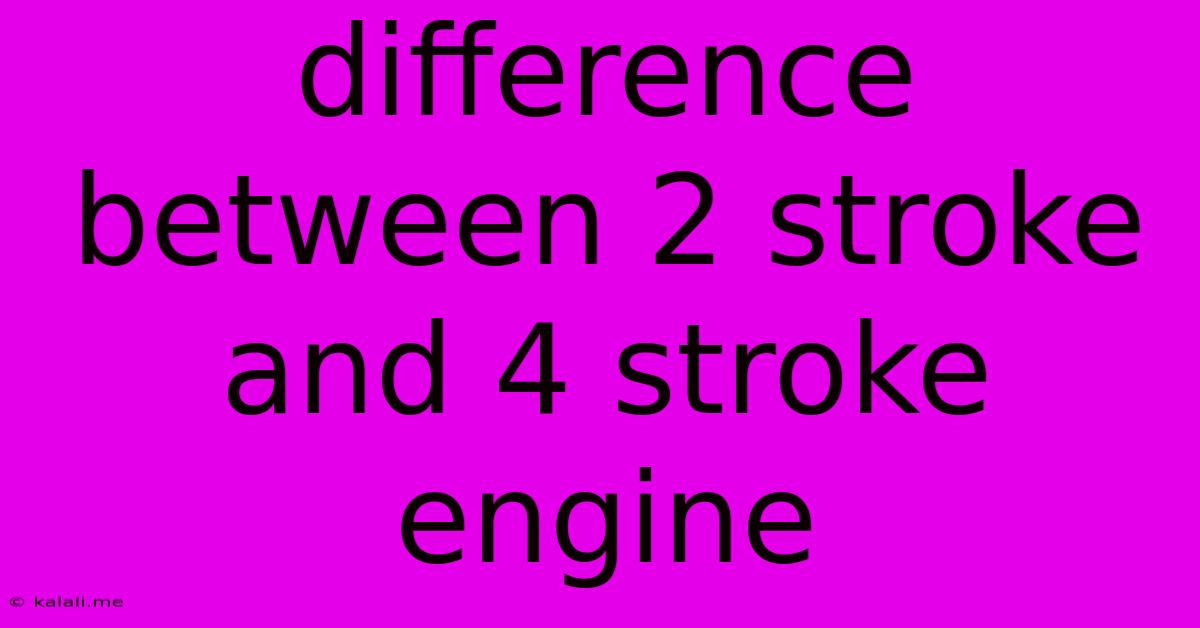Difference Between 2 Stroke And 4 Stroke Engine
Kalali
Jun 07, 2025 · 3 min read

Table of Contents
The Great Debate: 2-Stroke vs. 4-Stroke Engines – What's the Difference?
Choosing the right engine for your needs can be confusing, especially when faced with the seemingly similar 2-stroke and 4-stroke options. This comprehensive guide breaks down the key differences between these two engine types, helping you understand their strengths, weaknesses, and ideal applications. Whether you're a seasoned mechanic or a curious novice, this article will equip you with the knowledge to make an informed decision.
What are 2-stroke and 4-stroke engines? The terms "2-stroke" and "4-stroke" refer to the number of piston strokes required to complete one combustion cycle. Each stroke is a single movement of the piston, either up or down within the cylinder. This fundamental difference impacts engine design, performance characteristics, and maintenance requirements.
Understanding the 2-Stroke Engine
A 2-stroke engine completes a power cycle with only two piston strokes: a compression stroke and a power stroke. This efficiency in completing a cycle leads to higher power-to-weight ratios compared to their 4-stroke counterparts. However, this efficiency comes at a cost.
How it works:
- Intake and Compression: As the piston moves upwards, the fuel-air mixture is drawn into the crankcase through the intake port. Simultaneously, the previously compressed mixture in the combustion chamber is ignited, pushing the piston downwards.
- Power and Exhaust: As the piston travels downwards, the expanding gases drive the piston, creating power. The spent gases are pushed out through the exhaust port as the piston rises again, completing the cycle.
Advantages of 2-Stroke Engines:
- Lightweight and Compact: Ideal for applications where space and weight are crucial, such as motorcycles, chainsaws, and outboard motors.
- Higher Power-to-Weight Ratio: Delivers more power for its size, making it suitable for performance-oriented applications.
- Simpler Design: Fewer moving parts compared to 4-stroke engines resulting in generally simpler construction and maintenance.
Disadvantages of 2-Stroke Engines:
- Higher Emissions: They produce significantly more unburnt hydrocarbons and other pollutants.
- Less Fuel Efficient: Generally consume more fuel than 4-stroke engines for the same power output.
- Higher Maintenance: Requires more frequent maintenance, particularly lubrication, due to the mixing of oil and fuel.
- Noisy Operation: Tends to be louder than 4-stroke engines due to the rapid combustion cycles.
Understanding the 4-Stroke Engine
A 4-stroke engine completes a power cycle in four piston strokes: intake, compression, power, and exhaust. This more complex process leads to higher fuel efficiency and lower emissions compared to 2-stroke engines.
How it works:
- Intake: The piston moves downwards, drawing in a fresh fuel-air mixture through the intake valve.
- Compression: The piston moves upwards, compressing the fuel-air mixture.
- Power: The compressed mixture is ignited, forcing the piston downwards, generating power.
- Exhaust: The piston moves upwards, pushing the spent gases out through the exhaust valve.
Advantages of 4-Stroke Engines:
- Higher Fuel Efficiency: Significantly more fuel-efficient than 2-stroke engines.
- Lower Emissions: Produce fewer harmful emissions, making them more environmentally friendly.
- Quieter Operation: Generally operates more quietly than 2-stroke engines.
- Longer Lifespan: Typically have a longer lifespan due to less wear and tear on components.
Disadvantages of 4-Stroke Engines:
- Heavier and Larger: Generally heavier and bulkier than 2-stroke engines.
- Lower Power-to-Weight Ratio: Produces less power for its size compared to 2-stroke engines.
- More Complex Design: More moving parts, resulting in a more complex design and potentially higher maintenance costs.
2-Stroke vs. 4-Stroke: The Verdict
The "better" engine type depends entirely on the application. 2-stroke engines excel in scenarios prioritizing lightweight, compact design and high power-to-weight ratios, such as small recreational vehicles. Conversely, 4-stroke engines are favored where fuel efficiency, lower emissions, and quieter operation are paramount, making them suitable for automobiles and larger machinery. Understanding these fundamental differences will help you choose the right engine for your specific needs.
Latest Posts
Latest Posts
-
Cant Use Suica Galaxy Watch 6
Jun 07, 2025
-
Print Pdf With Line Numbers And Page Numbers
Jun 07, 2025
-
Best Noise Cancelling Ear Muffs For Planes
Jun 07, 2025
-
I Dont Have To Show No Stinking Badges
Jun 07, 2025
-
How To Know What Parts Were Replaced On Refurbished Earbuds
Jun 07, 2025
Related Post
Thank you for visiting our website which covers about Difference Between 2 Stroke And 4 Stroke Engine . We hope the information provided has been useful to you. Feel free to contact us if you have any questions or need further assistance. See you next time and don't miss to bookmark.